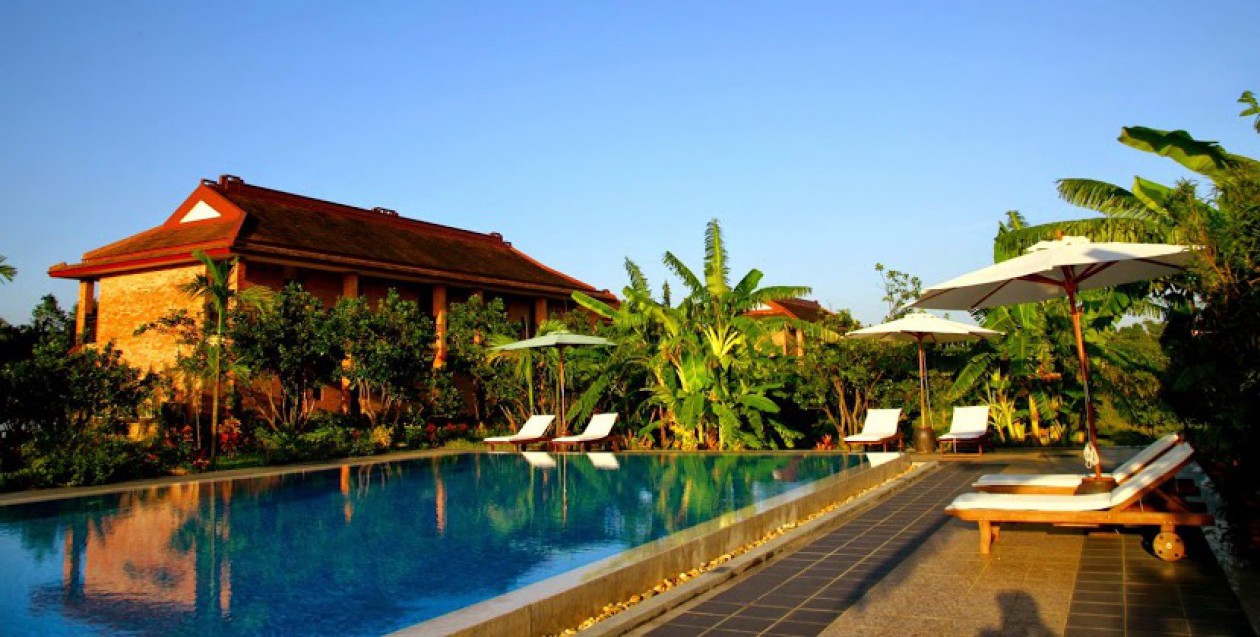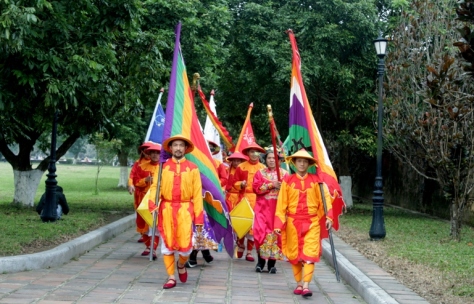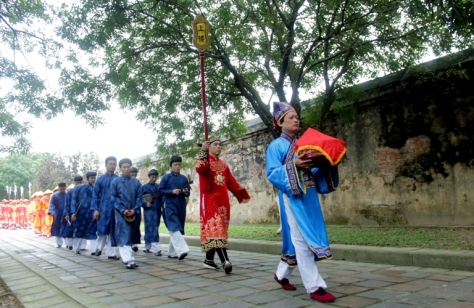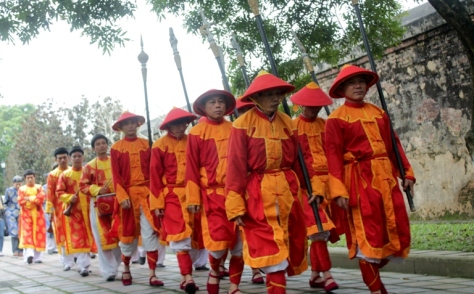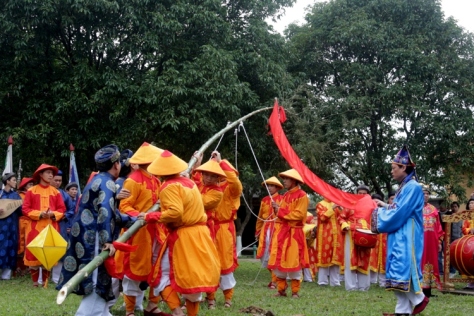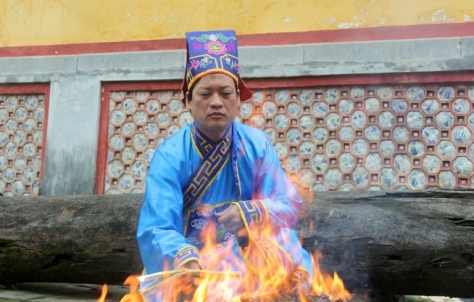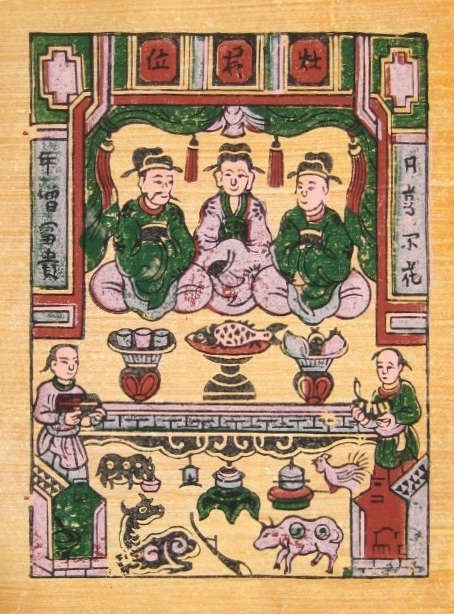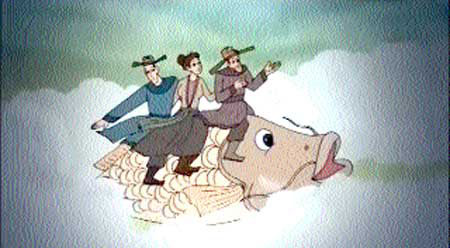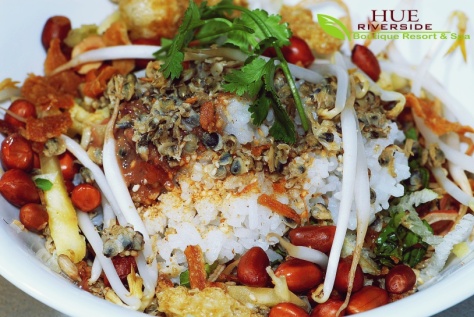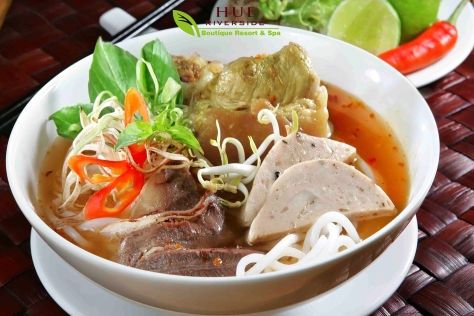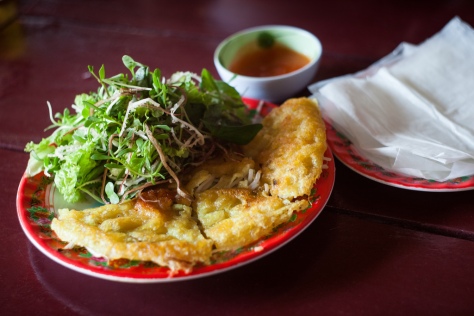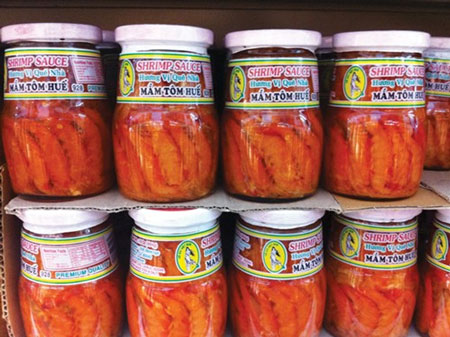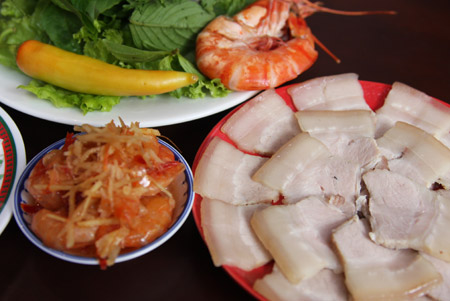Source: http://www.hueworldheritage.org.vn/
Author: Hải Trung/translated by Ý Nhi
Photo: Ý Nhi
The Tet pole erecting at Hue Imperial city is rehabilitated at Hue Monuments Conservation Centre in the early morning of Lunar December 23th. Basing on the historical background, the Centre has compiled a scenario to create a highlighted royal activity bringing about the animated atmosphere in the Lunar New Year.
To begin the poem “My mother’s Tet”, poet Nguyễn Bính wrote :
“My mother is strenuous at Tet
A great many thing she must catch
The brick yard, the lime wall… all of that
The holy circle, the Tet pole she herself sets”
The verse reminds me of the atmosphere of the Tet preparation in the Vietnamese spiritual life. Especially, it mentions the Tet pole erecting, a rite that is significant with the Vietnamese ancients taken root, inherited and promoted in different ways. This is a popular rite in the folk, Buddhism and royal life of Nguyễn dynasty.
The Tet pole erecting in the ancient folk
For that reason, the Buddha taught that in front of each house, it was needed to erect the high bamboo pole above which the flag and chime were hung. Besides, on the ground, people must create a circle of lime and the arch together with the arrow around the pole as the limitation. The higher the bamboo tree might be, the further the devils would be from that. The hanging of chime or gong was to create the sounds for threatening the devils. In the folk, people also prepared the altar to welcome the genie with the bamboo basket keeping the areca-nut and betel, gold and silver, red vertical flag, chime, the pandanus amaryllifolius or the banyan leaves. Next, people created the lime circle as the territory that was several tens meters from the Tet pole, the arch and arrows focusing on the direction where the devil stayed. Some families also hung the amulet or the caryota mitis to prevent the devils.As legend goes, the Tet pole erecting belongs to the Buddhism. In the old time, the devil often occupied the land of human, and the Buddha helped the people against that. With the abundant mysteries, the Buddha drove away the devils, but at the same time took off their capacity of finding food. Hence, they entreated the Buddha to let them know where would be his land so that they were able ignore. The Buddha, hence, told them that wherever there were the chime or gong sounds and flag, there would be his land.
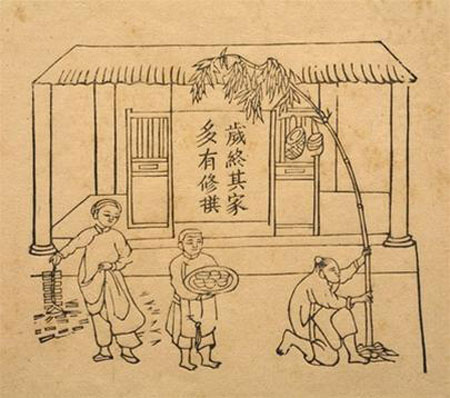 The Tet pole erecting (the wooden picture printed in the Technique du peuple Annamite of Henri Oger compiled in 1908
The Tet pole erecting (the wooden picture printed in the Technique du peuple Annamite of Henri Oger compiled in 1908
The Northern people of Vietnam erected the pole in Lunar December 23rd since in the early morning of this day, the Kitchen Genie were left for the meeting in the heaven. Without these genie, the devils may devastate the folk. Thus, the Tet pole was erected until Lunar January 7th for driving the devils.
The Tet pole erecting in the ancient imperial city
In the life of Hue former imperial family, before Tet the Tet pole erecting ceremony was taken place to inform the coming of the new year. The word Tiêu (標) (Tet pole) in the Tet pole erecting (上標) means the “top of the tree” at the highest point for the convenience of observation. Before Tet, the Tet pole erecting was held to mark the coming of the new year. Its original purpose was to welcome the Tet, then to worship the genie and ancestors for the goodness of their family. The dynasty also wished for the great peace and the natural harmony and public prosperity.
In the royal poem of Minh Mạng emperor, there mentioned the verse with the image of the Tet pole as follows: I wonder why the spring time has yet to be warm/It’s cold as the days have gone/The winter turns colder with rain squalls/The Tet pole is wrapped with the chilly wind.
In this poem, the emperor explained in details the Tet pole erecting ceremony. As regulated, as soon as the Lunar December 25th, no document would be received. This day was for the ceremonies of closing the seal and Tet pole erecting. As for the second ceremony, people used a bamboo tree on which there hung a bamboo chime, a bamboo basket keeping the paper currency, areca and betel nut, the amulet (on which there wrote the genie’s names) to worship the genie. Apart from keeping the genie’s name, on the amulet, the spring couplets were written like what had been done under the Song dynasty of China.
Besides, Minh Mạng emperor thought that the emperor must not be restful. Moreover, if the seal was closed or hidden, how could the urgent political affairs be solved? According to the order of Minh Mạng emperor, in each of the Tet pole erecting, the dynasty only chose some seals of minor importance to be symbolically hung on the bamboo basket. Until Lunar January 7th, the royal seals were opened, and the Tet pole was detached, and then the “Genie Seeing-Off” was carried out to begin a new year.
Under the reign of Tự Đức emperor, however, the dynasty regulated that until the Lunar December 30th was the Tet pole erected. That meant the Tet holiday was shorter. When the Tet pole was erected, it was the time for the vacation of Tet.
As regulated, after people saw the royal Tet pole, the mass would soon start erecting the pole for their families. The Tet pole erecting of the mass must be after that of the dynasty. Tú Xương’s poem reflected this regulation as follows:
“The spring has just informed from the dynasty
The spring belongs to all, not only to one properly.”
The Tet pole was erected as an introduction of Tet. Nguyễn Khuyến in his retirement, due to the poor condition of eyes, did stumble over the Tet pole erected at night of December 30th.
“The sound of fire cracker I hear at the last day of the year informs me it’s Tet,
The Tet pole I stumble over at the first day of the year tells me that’s spring.”
The restoration of the Tet pole erecting at present Imperial City
From Hiển Nhơn gate, the Tet pole escorting is taken place out solemnly. 10 guardians carrying the Tet pole in shoulders are well dressed. The ensemble starts with the sounds of Small Music, go further to the Imperial City and arrive at the main entrance of Thế Miếu Temple, the incense table together with the offerings are well prepared. The Tet pole erecting ceremony is solemnly organized. Such rites as Genie welcoming and Genie Seeing-off are taken place with the sounds of the Great Music. After the that, the 10 guardian erect the Tet pole.The Tet pole erecting at Hue Imperial city is rehabilitated at Hue Monuments Conservation Centre in the early morning of Lunar December 23th. Basing on the historical background, the Centre has compiled a scenario to create a highlighted royal activity bringing about the animated atmosphere in the Lunar New Year.
 The Tet pole erecting at Thế Miếu Temple
The Tet pole erecting at Thế Miếu Temple
After the ceremony at Thế Miếu Temple, the Tet pole erecting will be done at many other places within the complex of Hue Monuments with simpler scale from Lunar December 28th to 30th. Tourists and local people coming to hue relics these days may see a cultural beauty of Vietnamese people that has been maintaining in present time.
The Tet pole image has long been considered the most solemn symbol of Vietnamese Lunar New Year. It connects to a profoundly humane legend. The Tet pole erecting in the springtime is for the good hope of the coming year. The Tet pole under the sunshine expresses the awakening spring power in the hearts the Vietnamese. Those are nice significances transformed by Vietnamese ancients to the young generations. For this reason, at many Vietnamese villages in the days before Tet, many families set up the Tet pole in front of the village temple in the witness of the villagers. Many Hue culture address have enhanced this traditional cultural beauty by carrying out the Tet pole erecting formally.
The Tet pole erecting is a long-standing tradition of Vietnamese people. In the first days of the year, this ceremony brings about the animated atmosphere. It is not popular not only in hue but nationwide until now.
Some photo about Tet pole erecting in Hue Imperial City.
Photo by Ý Nhi
